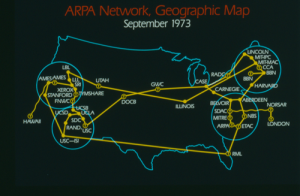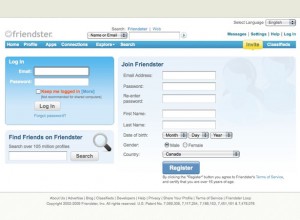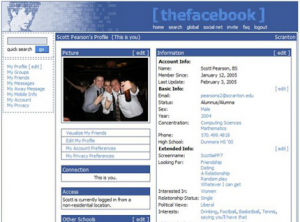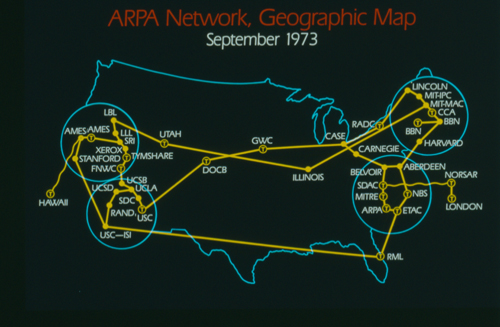Guest Blog by Nicole Macfarlane

Social media is as old as the Internet itself; as soon as we were connected we were making our own local chat servers and discussion boards.
Before the Internet
Telephone and radio were invented in 1890 and 1891 respectively. This marked the start of the information age for humans – prior to this, we communicated mostly via physical mail. The invention of the telephone was particularly important, as it literally laid the foundation for what became the Internet.
Our “Internet” – DARPANET
Initially ARPANET (Advanced Research Projects Agency network) renamed DARPANET (Department of Advanced Research Projects Agency Network) is the project that eventually became the Internet. Started by the US government as a means of communication, in 1969 four universities were connected and successfully communicated. Eventually growing to encompass the entire united states with Norway and London added shortly after, followed by the rest of the world.
Original ARPA Network
Early Internet communication
Three major technologies emerged pretty quickly and became fairly core to the operation of our social networks.
IRC (Internet Relay Chat) was a popular chat program. Users could connect to servers set up by peers and talk to large groups of people at a time. This idea of a centralized basic chat server hasn’t gone anywhere – IRC in its traditional form is still alive today, and IRC is employed in the back-end of a lot of public chat programs underneath all their bells and whistles.
Bulletin Board System (BBS) was the beginning of public forums. Typically community managed, people could register and post threads for other people to see. Better for slow communication, this was typically used to plan events and ask for advice to wider audiences within a community. The core idea is still alive in a lot of smaller online communities, and many programs have similarly structured components – Blackboard itself has a discussion section.
Around this time E-mail became a thing. Originally a service offered by AOL and CompuSERVE, this technology quickly spread with everyone wanting an email address. I’m assuming everyone reading knows how E-mail works, so I’ll leave it at that.
SixDegrees: The first major social networking website.

Networking being the key term, SixDegrees was built around the idea that no person is separated from another by more than six people. It started the idea of social networks mapping the human condition. It allowed users to create profiles, invite friends, and manage groups to talk to other people. In the end it failed, it pushed the six degrees of communication very hard – users felt pressured to invite people they knew, and accept group invites from people they didn’t know. That, in combination with a large amount of spam accounts, signaled the demise of the website.
Friendster

The next major social networking site to pick up where SixDegrees failed was Friendster. Calling the SixDegrees principle its “Circle of Friends”, it boasted features similar to a dating website. Ultimately it failed, users wanted features the website wasn’t providing, the site was riddled with technical issues, and poor management decisions (namely not implementing new features fast enough) signaled its demise. Eventually they changed to try to appeal to a niche – in their case, the “gaming” audience. As of June 2015 their web services are officially paused and looking at their website (http://www.friendster.com/) only shows a notice that they are “taking a break.”
MySpace
The next major website to come along was MySpace. Most people probably recognize it, it’s the first major social media website a lot of people became familiar with. Learning

from the mistakes of its predecessors, it boasted a lot of cool features to attract the disappointed Friendster audience. It gained a lot of popularity among teenagers due to the large focus on sharing music, a lot of popular bands shared songs and other information through MySpace at the time. The website, while still around and functional, ended up a failure. They offered a lot of non-targeted ads to gain revenue, which ended up causing them problems. Non-targeted ads tend to include ads with mature content, and since they had a large amount of younger users, they began to run into trouble for exposing minors to pornographic content. This led to a lot of musicians no longer using the site, and they began to hemorrhage users.

Originally launched in 2004 to Harvard students, they opened their doors to the world in 2006. Possessing all of the features of its predecessors but none of the faults, they quickly grew to the social networking giant we know today. Instead of large amounts of generic ads, Facebook tailored ads to what users liked or what they think they’d like. This allowed them to show less ads, have the ads be more likely to be clicked due to relevance, and charge more to people who wanted to advertise on their website. In addition, while MySpace required HTML knowledge to fully customize your profile, Facebook is very easy for everyone to customize their profile to their liking.
Social networking in 2016
As we sit currently, Facebook is the king of social networking in most of the world. A lot of other services have popped up to compliment each other (Instagram, Twitter, etc). Social media is at the highest point of popularity in its existence, with the advent of smart phones everyone is always connected. Perhaps Facebook will fall and Google+ will take its place, or perhaps the amount of investment people have in it will keep it going for a very long time.
Sources
Digital Trends (2014). The history of social networking. Retrieved from http://www.digitaltrends.com/features/the-history-of-social-networking/
Hendriks, D. (2013). Complete History of Social Media: Then And Now. Retrieved from http://smallbiztrends.com/2013/05/the-complete-history-of-social-media-infographic.html
Johnson, A. (2014). Why did myspace fail. Retrieved from http://www.gudideas.co.uk/social-marketing/why-did-myspace-fail-is-facebook-next
Leiner, B. et al. (ca. 2003). Brief History of the Internet. Retrieved from http://www.internetsociety.org/internet/what-internet/history-internet/brief-history-internet
Rouse, M. (2008). What is ARPANET? – Definition from WhatIs.com. Retrieved from http://searchnetworking.techtarget.com/definition/ARPANET
Vweb. (2017). History of the Internet. The Beacon. Retrieved from http://fios.verizon.com/history-of-the-internet/
*******************************
About the author: Nicole Macfarlane is a computer information systems student at the University of the Fraser Valley.

